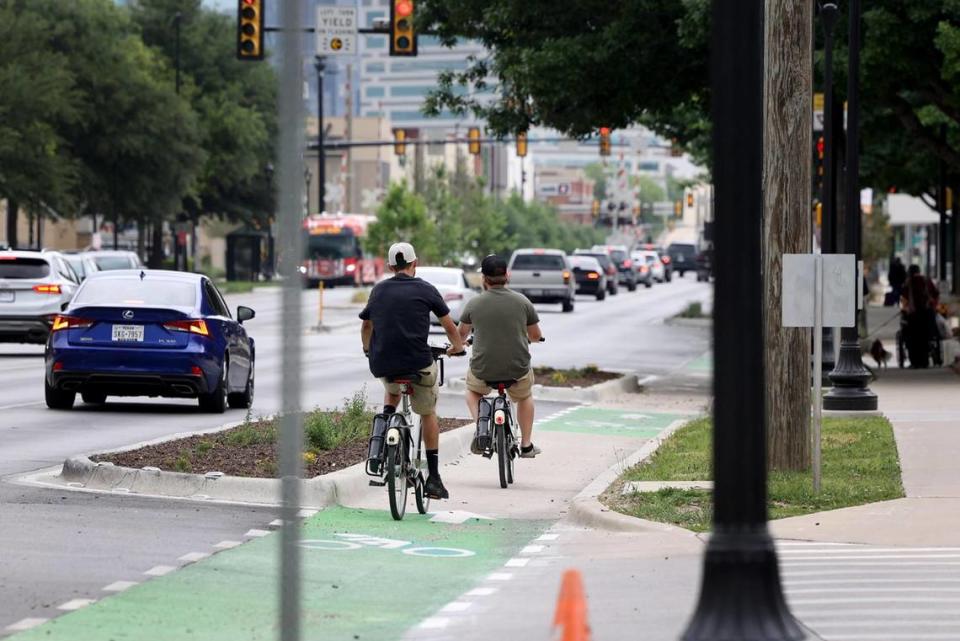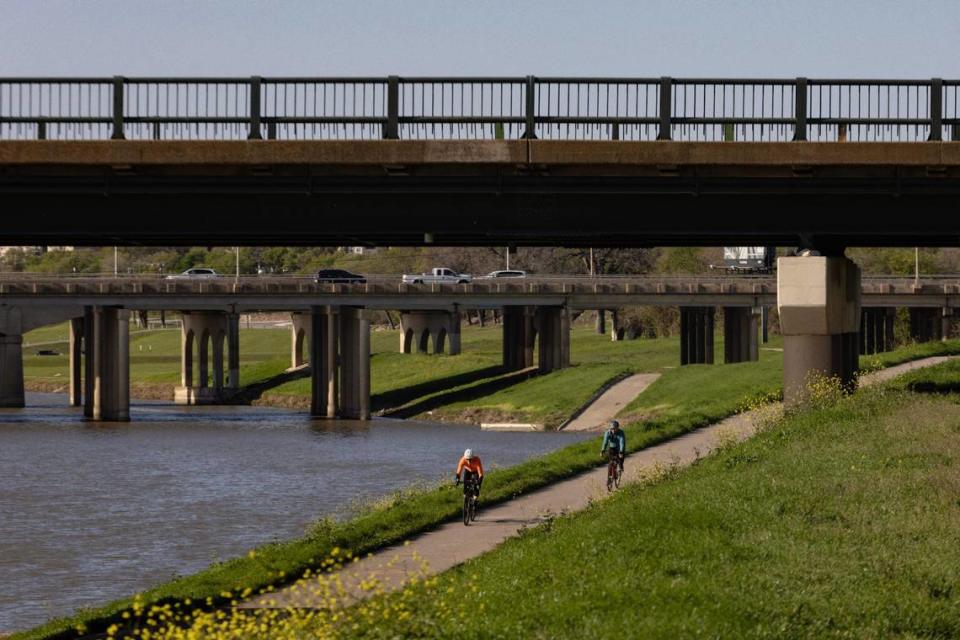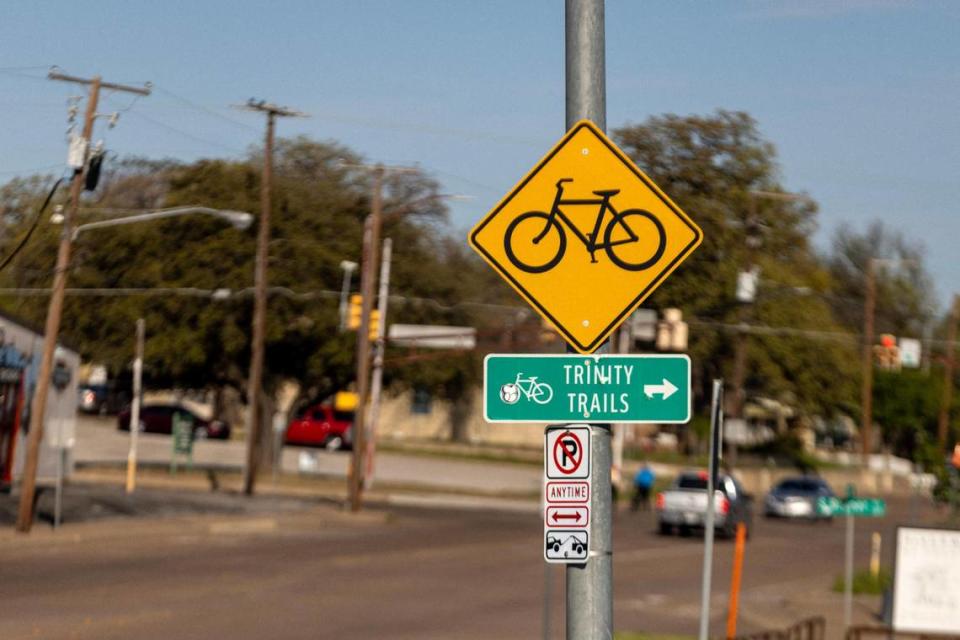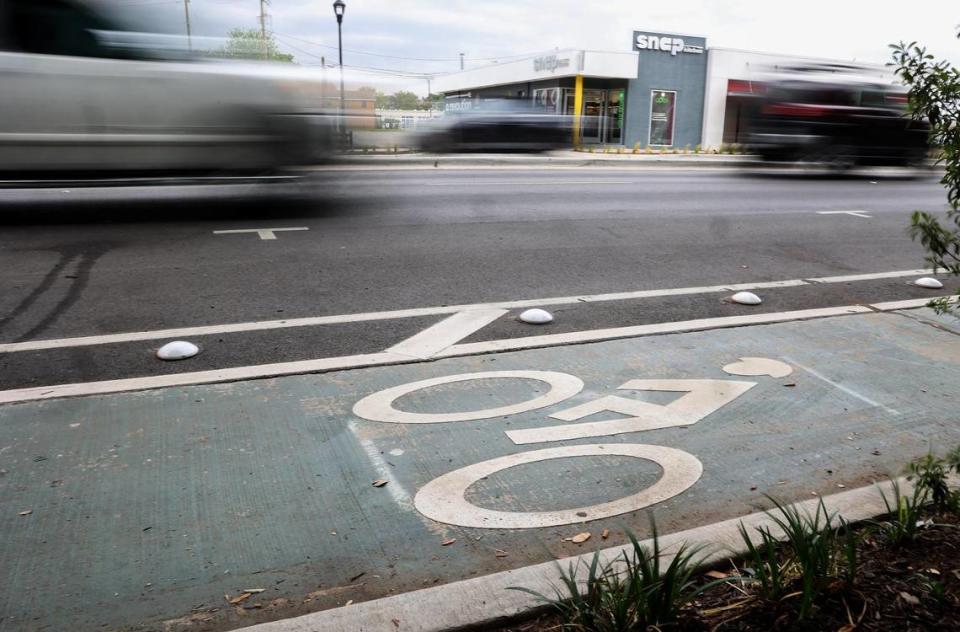Fort Worth’s bike lanes lead to nowhere. Here’s what the city has planned for cyclists
On a hot Monday afternoon, the newly protected bike lanes along Fort Worth’s West Seventh Street sit mostly unused.
A cyclist laden with saddle bags and a woman on a racing bicycle dart down the lanes that are otherwise occupied by dead leaves after a recent rain.
Though completed in December 2022, some of the lane markings are chipping like dead skin on a poorly moisturized hand.
Fort Worth taxpayers spent $8.5 million for road improvements on this stretch of West Seventh Street between University Drive and the Trinity River.
The roughly seven block stretch uses lane markings, bollards, and concrete planters to separate cyclists from traffic before it dumps them into an intersection where West Seventh Street meets Camp Bowie Boulevard, Bailey Avenue and University Drive. Here, the cyclists have to share a lane with pickups, city buses and harried motorists.

Across the city, a random network of bike lanes often leads to nowhere. Some lanes abruptly end, like the new one on West Seventh, while others bounce cyclists into traffic without warning, with “sharrows” directing them onto the streets.
The city is working from a 2019 plan to make Fort Worth’s bike lanes more connected, but doesn’t have a definitive timeline for when that will happen.
Projects like the West Seventh Street bike lanes are great, but they’re not useful if they are not connected to a unified system, said John Brown, a manager at the Trek bicycle store in south Fort Worth.
Only two-tenths of commuters bike to work in Fort Worth, according to the Census Bureau. Many have to navigate a web of trails, side streets and main roads to navigate the city safely.
Avid cyclists say the setup is better suited for leisure than getting around.
Bike plan
In a nutshell, the city’s wants to make it easier to get around Fort Worth without a car via a connected network of trails.
“Since I started commuting, it just it makes me feel a lot more connected to the area,” said Jarrod Salinas, who works at the south Fort Worth Trek store.
Cycling forces you to pay more attention as opposed to driving when everything goes by in a blur, Salinas said.
The city’s bike plan lays out 150 possible bike lane projects, although it doesn’t set a timeline.
The only performance measures when it comes to cyclists in the city’s plan is having zero bike deaths on city roads by 2030 and 10% more bike lanes within a half mile of majority-minority areas by 2025.
The city’s current network is too concentrated in areas like downtown and Near Southside where they’re less likely to be used for commuting, said Ashley Cassolopez, with the cycling advocacy group Fort Worth Critical Mass.

As part of the 2019 plan, the city is supposed to put out an annual scorecard keeping track of these goals on a web page dedicated to the plan, however, no scorecard is listed on the city’s website.
“There currently isn’t a scorecard or dashboard to our knowledge, but we are exploring several tools to track project status/progress in the future,” said Valerie Colapret, a spokesperson for the city’s transportation and public works department, in an email to the Star-Telegram.
When asked what the city is doing to improve connectivity, she pointed to the $6 million for for bike lanes from the 2022 bond. Fort Worth is trying to stretch that amount with funding from other city bond programs and money from the federal government, Colapret said.
She pointed to $2 million the city got from the federal government to put buffered bike lanes along Oakland Boulevard and Miller Avenue between East Berry Street and Randol Mill Road.
Another $5 million from the 2022 bond will fix about 30 roads that have high numbers of vehicle, bike and pedestrian crashes leading to injuries or death.

The biggest thing cyclists want is more connectivity.
Trek store manager Brown said the city’s lanes are great, but they’re not set up to help people commute.
It’s not clear whether every city road project going forward will include a bike lane, but Colapret said residents can expect to see more bike signals and separation going forward to make cyclists feel more safe.
The city currently has seven projects listed on its website involving some kind of bike lane.
The city is also applying for funding from state Transportation Department for projects on McPherson Boulevard, Everman Parkway and the Bomber Spur Trail, Colapret said.
Cars
Colonel’s Bike Shop owner Doug Coyle avoids city bike lanes. A customer of his was hit on West Seventh Street before the bike lanes were complete.
“This isn’t Seattle or Portland, you know, the automobile drivers aren’t that savvy when it comes to having bikes around,” he said.
Years of riding on Fort Worth streets to train for bike races took a toll on Trek store manager Brown’s body.

“I’ve had people try to run me off the road when they had an entire other lane to themselves,” Brown said. “It’s terrifying.”
That fight between cyclists and motorists is why the city needs more bike lanes, he said.
The city put out an instructional video in 2016, and signs inform drivers when there’s a bike lane present.

